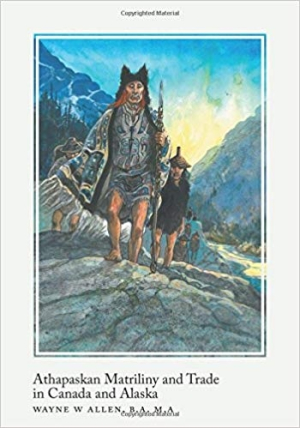
Athapaskan Matriliny and Trade in Canada and Alaska
This master’s thesis sets a foundation for further research into Pacific Northwest tribes.
Written as a master’s thesis in 1971 by Wayne W. Allen, Athapaskan Matriliny and Trade in Canada and Alaska examines the cultural influence of trade routes on indigenous peoples in northwest North America.
The first chapter summarizes past explanations for matrilineal organization among some groups native to the Pacific Northwest, then sketches both shared and differing social structures of various subgroups. Subsequent chapters examine trade interaction between Athapaskans and the Tlingits, while final chapters look at similarities and differences of other social features which may also have been influenced by contact through trade.
The work was not written for general readership. Initial chapters are written in turgid academese. The text’s foundational terms are undefined or scantily defined; only those familiar with anthropology and well studied in the subtribes of the region will find their way.
“Athapaskan” includes a broad tangle of subgroups, clans, and descent lines which maintain a variety of different relationships with each other. Sometimes the writing makes clear which of these many subgroups are aligned with which, and which clan or descent line belongs to which larger subgroup, but just as often it is not made clear. The Tlingit—non-Athapaskans whose interaction and trade seem to have influenced some Athapaskan subgroups—are sketched with a firmer, more confident hand.
Reliant on already published materials, the book feels cobbled together. There is no clarity to its collection of facts, which does not proffer fresh insights through synthesis. In describing the movements, organization, and interrelationship of groups, the text strings together assertions from multiple sources with little comment or clarifying text between. Including a short-form identifier after each citation is convenient but often prevents a unified point from emerging.
Moving from the initial effort to establish a link between matriliny and trade routes, chapters on trading practices between Athapaskans and Tlingits are written with more authority and a deescalation of academic jargon. The unusual partnership between these two peoples is truly fascinating. However, since these rendezvous were also used to arrange daughters’ marriages, the information is tangential to the theme of matrilineal control. To the thesis’s credit, instances of matriliny are not overplayed, and contradictory examples are freely cited.
The dated nature of the thesis is a stumbling block. The sources it relies on are fifty to a hundred years old. Newer studies have not been incorporated or added to the otherwise sound bibliography. Both the writing style and the maps have an archaic feel. Color illustrations that divide the chapters are interesting but seem to have come, unattributed, from a young person’s textbook or adventure tale.
Athapaskan Matriliny and Trade in Canada and Alaska establishes commonality between trade routes and matriliny in some subgroups and is a springboard for further research.
Reviewed by
Susan Waggoner
Disclosure: This article is not an endorsement, but a review. The publisher of this book provided free copies of the book and paid a small fee to have their book reviewed by a professional reviewer. Foreword Reviews and Clarion Reviews make no guarantee that the publisher will receive a positive review. Foreword Magazine, Inc. is disclosing this in accordance with the Federal Trade Commission’s 16 CFR, Part 255.
